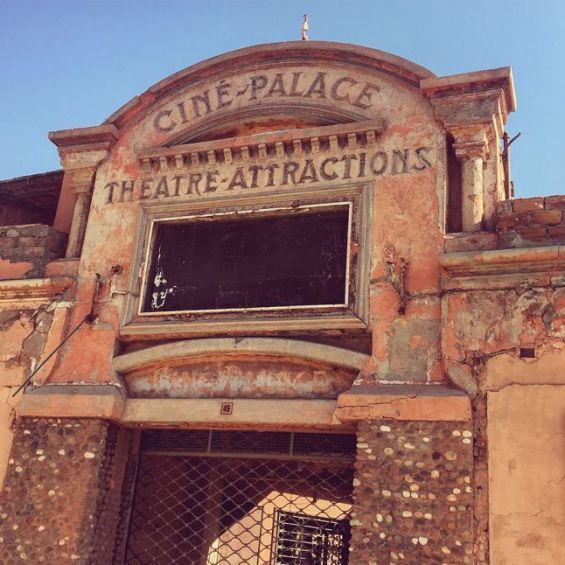During the last century, Morocco was home to hundreds of movie theaters. In the 1980s, the Kingdom had around 270 functioning theaters, the number that drastically diminished to around 30.
Many cinemas shut their doors, serving as evidence to Morocco’s dying movie-going industry. However, most of these movie theaters had stories to tell, leaving behind funny anecdotes, sad memories and unusual accounts.
Cinema Salam, where Godzilla was once released
In the 1940s, the capital of the Souss-Massa region saw the construction of one of its most emblematic movie theaters. Cinema Salam stands in the middle of the industrial quarter of Agadir, with an unusual yet interesting story to tell.
The movie theater was designed by French architect George Appéré and built by Moroccan businessman Boubker Fakih Tetouani in 1946. The building, whose architecture and design were hard to miss, was owned by another Agadir-based businessman called Yahia Yahia or Si Yahia Ben Idder, accounts say.
Spanned on a 1,200 square meters area, Cinema Salam was the go-to place for young people and movies lovers alike during the 40s, 50s and 60s, wrote French-language newspaper Le360. In addition to its modern, unusual and artsy outer architecture, the movie theater rose to fame after a dramatic coincidence that took place during the 1960s.
On February 29, 1960, Agadir was struck by one of Morocco’s deadliest earthquakes. While the city was falling apart, 400 people were inside Cinema Salam, watching, for the first time, the 1954 Japanese film «Godzilla», wrote Anadolu in a 2015 article.
And while «Godzilla», a fictitious giant dinosaur, was destroying a Japanese island in the movie, the city of Agadir was wrecked by the earthquake. When the movie theater’s attendees left Cinema Salam, they thought «Godzilla» had left the big screen and attacked their city as well.
Cinema Salam survived the earthquake, remaining Agadir’s sole operating movie theater until the 1980s. Currently closed, Salam is one of the many movie theaters that suffered due to the struggling movie industry in the Kingdom.

Cinema Marhaba, when a movie theater becomes a shopping mall
Unlike Ciné Salam, «Marhaba», a movie theater facing the beach in El Jadida, was turned into a shopping mall after it was sold and destroyed in the early 2000s. French-language daily L’Economiste recalls that Cinema Marhaba was one of the few venues that entertained the inhabitants of the city.
Marhaba opened its doors in 1953. It was one of the local projects funded and initiated by a business called Societé Parquet. The latter decided to build a movie theater in El Jadida as part of a tourism initiative planned to attract and entertain the clients of a hotel it owned in the same city.
For years, Marhaba attracted many movies lovers, including an El Jadida-native who still remembers the last time he attended a movie there. In the late 1990s, the former El Jadida inhabitant went to Marhaba to watch the then newly released James Cameron film «Titanic».
However, his afternoon did not go as planned. In the middle of the movie, attendees «lost their minds over the events of the movie and started fighting», he said. The audience spread into two main groups, those who supported the love story of Jack and Rose, the movie’s protagonists, and those who felt sorry for Rose’s fiancé.
«The two groups started fighting and they damaged some of the movie theaters’ equipment, including the chairs», he recalled, adding that the authorities had even intervened to put an end to the «chaos» that occurred.
It was the last time that the man set a foot in Marhaba as he believes that it closed its doors shortly after that incident. On the other hand, L’Economiste indicates that the movie theater was destroyed on January 5, 2001 after it was sold to a Moroccan entrepreneur. The latter replaced the venue with a shopping mall.

Ciné-Palace theater, Marrakech’s legendary cultural complex
Ciné-Palace stood still for thirty years, but ended up succumbing to the skyrocketing hotels surrounding it. Ciné-Palace theater of Marrakech is located in boulevard Moulay Rachid in Guéliz.
Built in 1926 by architect Serge Escharavil while the country was under French protectorate, the complex was the idea of a man known as «Monsieur Friggeri» who dreamed of building an artsy movie theater. Indeed, Ciné-Palace was the Marrakech version of the Eden, the oldest cinema. At the time of its opening, Ciné-Palace Théâtre was considered as «the first multicultural place in the Kingdom».
Originally, the complex had two covered rooms, including Cinema Lux and an open-air room. «The best troupes of the time and internationally recognized stars such as Nate King Cole or Rita Hayworth also performed there in the 1930s», reported Marrakech Pocket magazine.
But the 40 years of success of this complex couldn’t prevent its owners from surrendering. The legendary Ciné-Palace Théâtre was then closed in 1984, leaving the building abandoned.
In 2014, and thanks to the mobilization of associative actors, like the local section of NGO Save Cinemas in Morocco, it opened its doors one last time to host the «Guéliz en fête» event on the World Heritage Day.
But, after almost a century of existence, the Ciné-Palace Théâtre was partially destroyed in October 2018. On its Facebook page, Save Cinemas in Morocco said that the building would be replaced by a hotel.

El Gran Teatro Cervantes, a theater rising from its ashes
Although it celebrated its centenary in 2013, El Gran Teatro Cervantes, Cervantes theater in Tangier, was abandoned for many years.
Built between 1911 and 1913 by Spanish couple, Manuel Peña and Doña Esperanza Orellana, the majestic theater was inaugurated in 1913, with a capacity of 1,400 seats, making it, at the time, a cultural gem in the city.
Thanks to architect Diego Jiménez Armstrong, the building was one of the «first reinforced concrete buildings of the time, with equipment that had to be imported from Spain», Made-in-Tangier reported.
During its long life, El Gran Teatro Cervantes was the go-to venue in Tangier. The theater housed plays such Shakespeare's Othelo and Nagib Hadded's Saladin and welcomed stars like Enrico Caruso, French actress Cécile Sorel, and Egyptian star Youssef Wahbi, wrote France Culture. Big Spanish stars had performed on its stage.
At some point, the theater became a «cinema and wrestling room». Transferred by its owners to the Spanish state, the theater was however shut down in 1974, although it was «long rented for a symbolic dirham in Morocco», wrote Le Monde last February.
And it was this year that Spain announced that it was handing over this building to the government of Morocco. An «irrevocable gift» that Morocco has pledged to restore. Last July, the Spanish agency EFE indicated that the council of the Tangier-Tetouan-Al Hoceima region approved a budget of 5 million dirhams for the restoration of El Gran Teatro Cervantes.





 chargement...
chargement...












